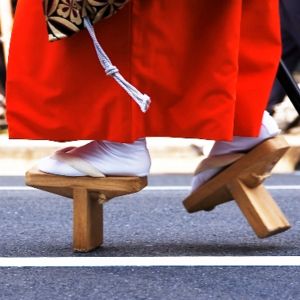Geta: Difference between revisions
imported>Caesar Schinas m (Bot: Update image code) |
imported>John Stephenson (geta-throwing; cleanup) |
||
| Line 1: | Line 1: | ||
{{subpages}} | {{subpages}} | ||
{{Image|Geta.jpg|right|150px|Two-'toothed' ''geta''.}} | {{Image|Geta.jpg|right|150px|Two-'toothed' ''geta''.}} | ||
A '''geta''' (下駄) is a kind of [[Japan|Japanese]] [[shoe]] with a flat [[wood]]en sole (台 ''dai'' 'stand') raised by one or more 'teeth' (歯 ''ha''). The [[foot]] holds the ''geta'' between the [[toe]]s via a [[V]]-shaped length of [[fabric]] (鼻緒, ''hanao''). They are often worn to accompany Japanese robes such as a [[kimono]] or a ''[[yukata]]'', particularly in [[summer]], sometimes with traditional [[ankle]]-high toe [[sock]]s called ''tabi'' (足袋). Both [[man|men]] and [[woman|women]] as well as [[child]]ren may wear ''geta'', with the design slightly adapted for [[age]] and [[sex]]. | A '''geta''' (下駄) is a kind of [[Japan|Japanese]] [[shoe]] with a flat [[wood]]en sole (台 ''dai'' 'stand') raised by one or more 'teeth' (歯 ''ha''). The [[foot]] holds the ''geta'' between the [[toe]]s via a [[V]]-shaped length of [[fabric]] (鼻緒, ''hanao''). They are often worn to accompany Japanese robes such as a [[kimono]] or a ''[[yukata]]'', particularly in [[summer]], sometimes with traditional [[ankle]]-high toe [[sock]]s called ''tabi'' (足袋). Both [[man|men]] and [[woman|women]] as well as [[child]]ren may wear ''geta'', with the design slightly adapted for [[age]] and [[sex]]. | ||
| Line 9: | Line 8: | ||
When choosing ''geta'', the Japanese may consider that the wooden ''dai'' should be slightly smaller the wearer's overall footprint; they will also tell you that wearing ''geta'' avoids [[flat feet]] and various other problems.<ref>See ''karankoron.com'' for tips on geta-wearing; apparently, the owner supplied footwear for the [[film]] ''[[Memoirs of a Geisha]]''</ref> | When choosing ''geta'', the Japanese may consider that the wooden ''dai'' should be slightly smaller the wearer's overall footprint; they will also tell you that wearing ''geta'' avoids [[flat feet]] and various other problems.<ref>See ''karankoron.com'' for tips on geta-wearing; apparently, the owner supplied footwear for the [[film]] ''[[Memoirs of a Geisha]]''</ref> | ||
''Geta'' are easy to slip on and off; this is important in Japan, where shoes are generally removed on entering a home, and are forbidden on [[tatami]] (畳) mats. Outdoors, they make a distinctive 'clacking' sound on hard surfaces unless [[rubber]] padding is fixed to the bottom of the 'teeth'; this sound is such a part of [[Culture of Japan|Japanese culture]] that an [[onomatopoeia|onomatopoeic]] [[word]] exists in [[Japanese language|Japanese]] to describe it: ''karankoron'' (カランコロン). In some cases, wearers may even use strips of old [[bicycle]] [[tyre]]s to soften ''karankoron''. | ''Geta'' are easy to slip on and off; this is important in Japan, where shoes are generally removed on entering a home, and are forbidden on [[tatami]] (畳) mats. The city of [[Kaminoyama]] (上山) in [[Yamagata prefecture]] (山形県 ''Yamagata-ken'') has an annual ''geta''-flicking contest (げた飛ばし大会 ''Geta Tobashi Taikai'') in which competitors try to throw ''geta'' the furthest with a flick of the foot. Outdoors, they make a distinctive 'clacking' sound on hard surfaces unless [[rubber]] padding is fixed to the bottom of the 'teeth'; this sound is such a part of [[Culture of Japan|Japanese culture]] that an [[onomatopoeia|onomatopoeic]] [[word]] exists in [[Japanese language|Japanese]] to describe it: ''karankoron'' (カランコロン). In some cases, wearers may even use strips of old [[bicycle]] [[tyre]]s to soften ''karankoron''. | ||
==Footnotes== | ==Footnotes== | ||
{{reflist|2}} | |||
==See also== | ==See also== | ||
*[[Culture of Japan]] | *[[Culture of Japan]] | ||
Latest revision as of 23:11, 22 September 2009
A geta (下駄) is a kind of Japanese shoe with a flat wooden sole (台 dai 'stand') raised by one or more 'teeth' (歯 ha). The foot holds the geta between the toes via a V-shaped length of fabric (鼻緒, hanao). They are often worn to accompany Japanese robes such as a kimono or a yukata, particularly in summer, sometimes with traditional ankle-high toe socks called tabi (足袋). Both men and women as well as children may wear geta, with the design slightly adapted for age and sex.
Wearing geta obviously make reaching a speedy pace rather difficult; this is even more so with tengu-geta (天狗下駄),[1] which have only one 'tooth'; these can resemble miniature stilts. Raised geta may also act to keep the feet clean and dry, and tengu-geta are sometimes used in mountain climbing.
When choosing geta, the Japanese may consider that the wooden dai should be slightly smaller the wearer's overall footprint; they will also tell you that wearing geta avoids flat feet and various other problems.[2]
Geta are easy to slip on and off; this is important in Japan, where shoes are generally removed on entering a home, and are forbidden on tatami (畳) mats. The city of Kaminoyama (上山) in Yamagata prefecture (山形県 Yamagata-ken) has an annual geta-flicking contest (げた飛ばし大会 Geta Tobashi Taikai) in which competitors try to throw geta the furthest with a flick of the foot. Outdoors, they make a distinctive 'clacking' sound on hard surfaces unless rubber padding is fixed to the bottom of the 'teeth'; this sound is such a part of Japanese culture that an onomatopoeic word exists in Japanese to describe it: karankoron (カランコロン). In some cases, wearers may even use strips of old bicycle tyres to soften karankoron.

